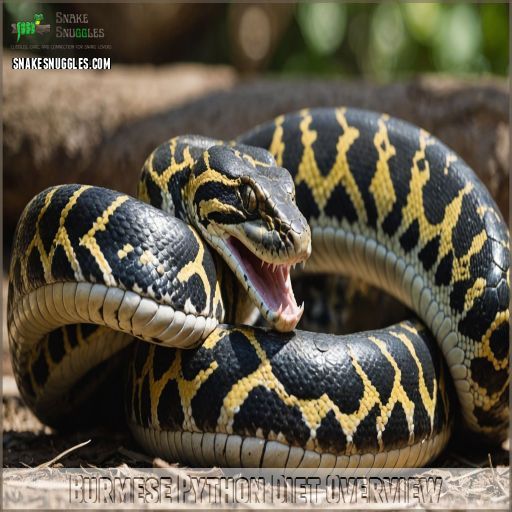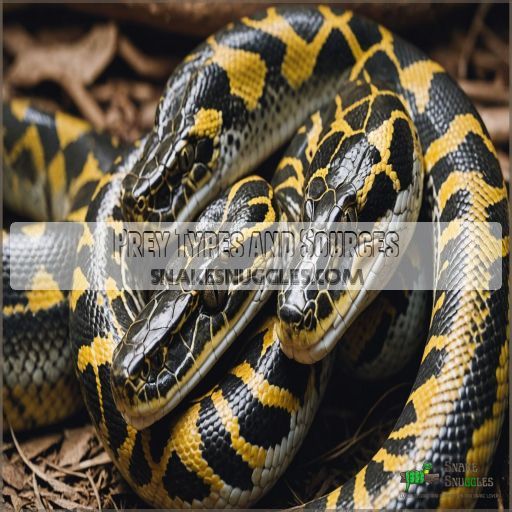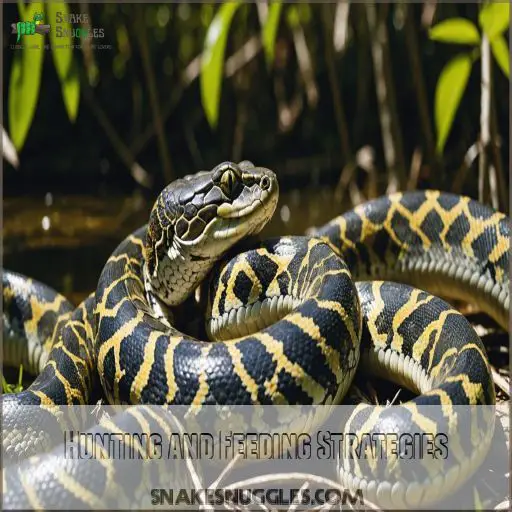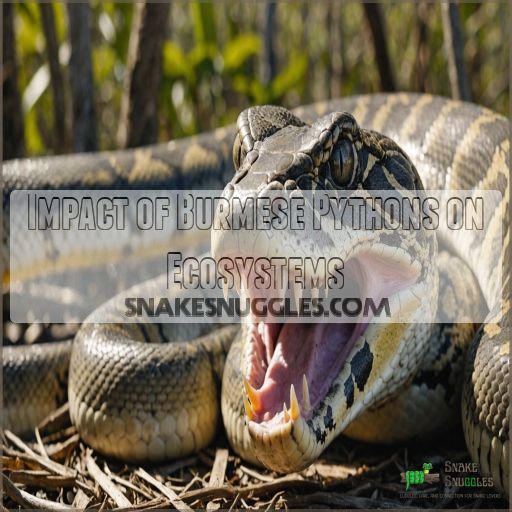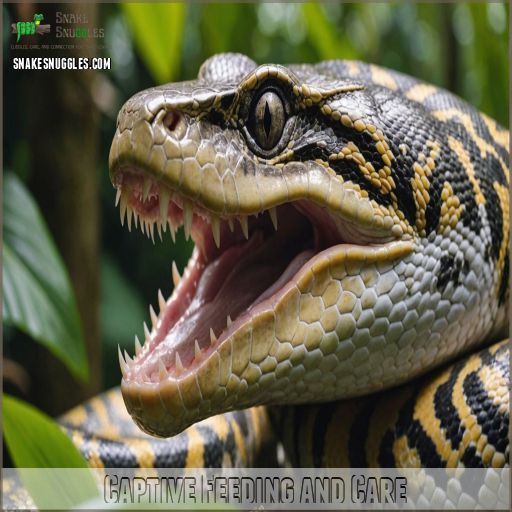This site is supported by our readers. We may earn a commission, at no cost to you, if you purchase through links.
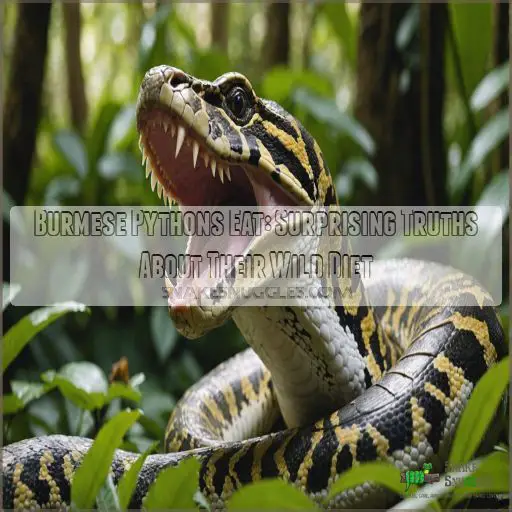 You’ll be surprised by the diverse menu of Burmese pythons! These apex predators feast on a wide array of prey, from cute little rodents to larger mammals like raccoons and pigs.
You’ll be surprised by the diverse menu of Burmese pythons! These apex predators feast on a wide array of prey, from cute little rodents to larger mammals like raccoons and pigs.
They even enjoy the occasional reptile or bird. How do they catch such a variety of critters? By using their heat-sensing abilities and constriction skills to ambush unsuspecting victims.
And get this – they can swallow prey up to six times the width of their jaws! Pretty impressive, right? But their dietary dominance comes at a cost, as they can disrupt local ecosystems.
Want to learn more about these fascinating snakes and their eating habits of wild snake diets
? Keep reading!
Table Of Contents
- Key Takeaways
- Burmese Python Diet Overview
- Prey Types and Sources
- Hunting and Feeding Strategies
- Impact of Burmese Pythons on Ecosystems
- Captive Feeding and Care
- Frequently Asked Questions (FAQs)
- Do Burmese pythons eat other snakes?
- What do pythons eat?
- Are Burmese pythons carnivores?
- How do Burmese pythons find food?
- What do Burmese pythons eat the most?
- What is the best food for Burmese python?
- What prey does Burmese python eat?
- What animal kills Burmese pythons?
- How long can Burmese pythons live without food?
- What is the usual feeding frequency for pythons?
- How do Burmese pythons capture larger prey?
- What challenges do pythons face when hunting?
- Can pythons safely consume animals with spines?
- Conclusion
Key Takeaways
- You’ll find that Burmese pythons aren’t picky eaters. They have a menu that includes everything from small rodents to sizable alligators, proving their title as apex predators. Picture them as the ultimate buffet connoisseurs, adapting their diet to whatever is available.
- These sneaky snakes use heat-sensing pits and masterful constriction to ambush their prey. Imagine them as the ninjas of the reptile world, waiting patiently before launching a swift and forceful attack—a true lesson in patience and precision.
- Burmese pythons have become ecological game-changers, especially in the Florida Everglades. Their voracious appetite and lack of natural predators mean they are having a significant impact.
- When it comes to dining, these pythons are all about the slow food movement. They can go weeks between meals, digesting slowly thanks to their impressive metabolic adaptations. Think of them as nature’s own version of a gourmet diner, savoring each hearty meal they manage to catch.
Burmese Python Diet Overview
When you think of Burmese pythons, a few things might come to mind: their size, their habitat, or perhaps even their feeding habits.
Burmese pythons are known to enjoy the occasional snack of small mammals and birds. However, these snakes have quite the adventurous diet!
From furry critters to feathered friends, their menu offers surprises that’ll make you rethink what it means to gulp down a meal.
Primary Food Sources
The Burmese python’s diet in the wild reflects its status as an apex predator with a diverse palate.
Imagine this:
- Rodents and rabbits: A tasty meal for the average python.
- Medium-sized mammals: Think raccoons or the occasional pig.
- Reptiles and birds: Perfect for a snake’s diverse menu.
This snake’s dining choices are as varied as the Florida Everglades itself.
Types of Prey Consumed
Imagine you’re a Burmese python surveying the bountiful buffet of south Florida.
Your menu includes small mammals like rabbits, birds, and even other reptiles.
In the vast Everglades, prey size can range from pesky rodents to deer.
With prey availability being key, your diet adapts, leading to significant prey impact and competition with native species.
Hunting and Feeding Habits
You might think Burmese python hunting is just a straightforward snack time, but oh no! They’re master hunters, blending into their surroundings like a secret agent.
These constrictor snakes from Southeast Asia rely on:
- Heat sensors for detecting prey.
- Chemical receptors that guide their strike.
- Constriction methods that guarantee dinner doesn’t squirm away.
Prey Size and Quantity
Burmese pythons aren’t picky eaters—they feast on creatures from rabbits to full-grown alligators! Prey size varies widely, and although a hungry python might devour a deer in one go, they’re generally opportunistic.
Feast your eyes on their diet:
| Prey Type | Size Range |
|---|---|
| Rodents | Small to Medium |
| Birds | Small to Large |
| Mammals | Medium to Large |
Ever see a snake with a deer-sized grin? That’s python dining!
Prey Types and Sources
Burmese pythons are true omnivores, feasting on a diverse array of prey from small rodents to large mammals.
Prepare to be amazed as we explore the surprising variety of creatures that end up on the menu for these impressive snakes.
Mammals and Birds
A feast awaits in terms of Burmese python prey, with a menu full of tasty mammals and birds.
Think pigs, rabbits, and even unsuspecting birds enjoying a sunny perch.
Their avian diet reflects their opportunistic nature; they’ll dine on any bird species they ambush.
While pythons don’t discriminate, their dietary preferences often tilt toward the furry and feathered.
Reptiles and Amphibians
Moving on from fluffy feathers, think of the Burmese python tackling scaly, cold-blooded creatures.
This apex predator snaps up reptiles and amphibians when the opportunity arises:
- Lizards basking unsuspectingly
- Croaking frogs in moonlit ponds
- Slinking snakes in leafy underbrush
- Small turtles sunbathing beside streams
- Young alligators testing swamp waters
These varied diets mimic large pet snake breeds and how to keep them healthy best large pet snake breeds that keep pythons as varied predators
.
Small Mammals and Rodents
Burmese python hatchling embarks on a quest for its first meal.
Prey of choice: small mammals and rodents.
With an impressive sense of smell and heat sensors, they are formidable, stealthy hunters, swiftly capturing unsuspecting prey.
Potential nature’s rodent control?
Larger Prey and Wild Animals
You might be surprised to learn that Burmese pythons, with their impressive size, can make a meal out of deer, pigs, and even alligators!
These invasive giants aren’t fussy eaters. Their hunting strategies, which include ambush and constriction, allow them to tackle large prey.
In the food chain, Burmese pythons hold a position at the top, impacting local wildlife and ecosystems in a big way.
Hunting and Feeding Strategies
Burmese pythons have a knack for sneaky ambushes and powerful python constriction abilities, making them effective predators in their native and invasive ranges
.
You’ll find them patiently lying in wait for just the right moment, striking out to wrap their coils around unsuspecting prey, ensuring both an unforgettable meal and quite the dinner date.
Constriction and Suffocation
Burmese pythons are masters of constriction, capable of generating immense crushing force.
As they wrap their muscular bodies around prey, the pressure cuts off blood flow and oxygen, causing major organs to rapidly shut down (Source).
This quick-acting suffocation is far more efficient than a prolonged squeeze, allowing these giants to overpower even large animals.
Ambushing and Attacking Prey
Pythons have a knack for ambushing prey, waiting like a coiled spring ready to strike.
Their hunting tactics include:
- Invisible camouflage in dense foliage
- Sharp senses to detect unsuspecting prey
- Lightning-fast attack methods
- Powerful contractions to immobilize victims
- A patient pursuit often lasting hours
It’s nature’s hide-and-seek, where the python holds all the cards.
Prey Capture and Consumption
Imagine you’re sneaking through marshes, searching for dinner every few days. That’s the life of a Burmese python, using ambush and constriction for successful hunting . They consume prey whole, relying on stretchy jaws to handle large meals, from rabbits to deer.
After a feast, it’s a slow dance of digestion over days, not hours. The python’s slow metabolism allows it to survive on infrequent meals, making it well-suited to its native habitat.
Ambush, constriction
Several days, slow metabolism
Feeding Frequency and Patterns
After capturing its meal using constriction, a young python’s metabolism kicks into high gear, promoting rapid growth.
Adult consumption patterns often fluctuate with prey availability and may eat large meals infrequently, sometimes equivalent to 25% of their body mass.
Like a gourmet diner with occasional feasts, they’re perfectly adapted to their wild buffet lifestyle, often enjoying large meals infrequently.
Impact of Burmese Pythons on Ecosystems
When Burmese pythons move into an ecosystem, they don’t just crash the party; they devour it, impacting nearly every creature around.
From munching on endangered birds to competing with native predators like alligators, these pythons aren’t shy about reshaping their neighborhoods.
Native Range and Prey Impact
In their native range, Burmese pythons enjoy a smorgasbord of prey, from small mammals to birds and even reptiles.
This diverse appetite helps maintain ecological balance.
However, their indiscriminate dining habits can lead to significant ecosystem effects, as these snakes may out-compete native predators and disrupt established food chains, though occasionally offering turtles a break from raccoon predation.
Invasive Range and Ecological Effects
The Burmese python’s unchecked invasion has overturned Florida’s ecosystem like a bull in a china shop.
Their voracious appetite led to the staggering decline of native species, including raccoons and bobcats, by over 90% (Source).
Yet, while conservation efforts work overtime to curb this slithering menace, nature’s tightrope appears shaky at best.
Competition With Native Predators
Burmese pythons pose a formidable challenge to native predators in the Everglades. These invasive snakes compete for food and resources, decimating populations of raccoons, opossums, and bobcats by over 87% since 1997 (Source). Even the mighty American alligator has been known to fall prey to these apex predators.
- Burmese pythons have no natural predators in the Everglades.
- Native animals lack instinctive defenses against these large, constricting snakes.
- The python’s voracious appetite threatens to disrupt the delicate Everglades food web.
Threats to Endangered Species
Imagine a silent predator slithering through the Everglades, threatening endangered bird populations like the wood stork.
Burmese pythons, with their insatiable hunger, have upended these fragile ecosystems.
As conservation efforts intensify, invasive species control aims to protect wildlife and restore balance.
It’s wildlife management at its finest—minding the snakes’ stealth, while humans tirelessly peel back their ecological footprint.
Captive Feeding and Care
Keeping a Burmese python as a pet means understanding its dietary needs and care is important for a happy and healthy snake.
You’ll find that feeding your python isn’t just about tossing in any critter; it’s a carefully planned process that might even rival your grocery list planning!
Dietary Requirements and Guidelines
When keeping Burmese pythons, you’ll frequently find their dietary needs vary with age.
They might start with mice and graduate to rabbits as adults.
- Feeding frequency: Every 7-10 days for juveniles, 4-6 weeks for adults.
- Prey selection: Mice, rats, and eventually rabbits.
- Nutritional needs: Make sure meals match snake size for safety.
Feeding Strategies and Techniques
You’ve got your python, now what? Feed it a small meal like mice or rats, gradually increasing size as it grows. Capturing prey involves using its heat-sensing pits for precise strikes, utilizing its pit viper ambush tactics
. Imagine the python wrapping around dinner like it’s hugging an old friend—tight!
| Prey Size | Feeding Frequency | Digestion Process |
|---|---|---|
| Hatchlings | Weekly | 1-2 Days |
| Juveniles | Every 10-14 Days | Up to a Week |
| Adults | Monthly | Several Weeks |
Captive feeding isn’t rocket science, but it requires care and patience.
Nutritional Needs and Recommendations
Burmese pythons thrive on a balanced diet, ensuring proper nutrition and growth. Feed them appropriately sized meals, like mice, rats, rabbits, or chickens, as they mature.
Consider their dietary needs, including:
- Feeding frequency: Every 7-10 days for juveniles, 4-6 weeks for adults.
- Diet variety: Balance mammals and birds.
- Supplements: Rarely needed.
Additionally, monitor and maintain their health and well-being through:
- Growth monitoring.
- Adequate hydration.
Environmental and Enclosure Considerations
When it comes to Burmese pythons, setting up their enclosure is like designing their personal paradise. Make sure you have a spacious enclosure, balance humidity levels, and control temperature.
Choose the right substrate for comfort, and always provide water. Jugglers aren’t the only ones who need balance—your python does too!
Enclosure Size
Humidity Levels
Temperature
Enclosure care isn’t rocket science—it’s snake science!
Frequently Asked Questions (FAQs)
Do Burmese pythons eat other snakes?
Curiosity won’t kill the cat here, but Burmese pythons do eat other snakes.
They’ve been known to consume reticulated pythons, even when the latter are larger, highlighting their formidable appetite and adaptability.
What do pythons eat?
Pythons are carnivorous and mainly eat mammals, birds, and reptiles.
Depending on the species, their diet includes rodents, birds, lizards, and even larger mammals like pigs or antelope.
They use constriction to subdue prey.
Are Burmese pythons carnivores?
You bet Burmese pythons are carnivores. They mainly feast on small mammals and birds, but when feeling extra hungry, they’ll go for larger prey like pigs and goats.
It’s a wild world for these snakes!
How do Burmese pythons find food?
Imagine you’re a Burmese python; you’re stealthy and precise, waiting silently for prey.
You rely on heat-sensing pits to detect warm-bodied animals, then ambush with incredible speed, followed by a deadly constriction.
What do Burmese pythons eat the most?
In an ironic twist, Burmese pythons, despite their grand size, mostly feast on small mammals like marsh rabbits and birds.
Occasionally, they ambitiously tackle larger prey, such as deer or even alligators, swallowing them whole.
What is the best food for Burmese python?
Burmese pythons thrive on a varied diet of small mammals, birds, and reptiles.
Offer appropriately sized rodents, rabbits, or poultry every 4-6 weeks for adults.
Juveniles may need feeding more frequently.
What prey does Burmese python eat?
You’ve got a curious yet mighty predator here!
Burmese pythons chow down on small mammals like rodents and raccoons.
While also tackling larger prey such as deer, pigs, and even gators when they’re feeling ambitious.
What animal kills Burmese pythons?
Curious about python hunters?
In Florida, young Burmese pythons face danger from alligators and birds, while some adult pythons occasionally meet their match with alligators too.
However, humans are still their primary predators , which makes humans their main threat, implying that humans are the primary predators.
How long can Burmese pythons live without food?
Pythons, with their slow metabolic rates, can fast impressively.
They mightn’t eat for months, even up to a year, by conserving energy through physiological adaptations.
It’s a strategy fitting for survival .
What is the usual feeding frequency for pythons?
With metabolic engines like slow-burning coals, adult Burmese pythons typically feast every 4 to 6 weeks . Growing youngsters, though, might chow down every 7 to 10 days, depending on prey size ,.
How do Burmese pythons capture larger prey?
Burmese pythons ambush their prey using remarkable stealth.
They wait motionless, blending into their surroundings until the perfect moment to strike.
Then, they constrict with overwhelming force, wrapping around the prey to suffocation before swallowing it whole using remarkable stealth.
What challenges do pythons face when hunting?
Spotting challenges, sneaky Burmese pythons often blend seamlessly into their environment, making them tough to detect.
Even seasoned hunters can go days without finding one, highlighting how these masters of disguise tackle the wild.
Can pythons safely consume animals with spines?
You bet your bottom dollar, these slithery serpents can really put the squeeze on critters with spines!
Their super-stretchy skin and mighty muscles let them swallow all sorts of prickly prey, from porcupines to pangolins.
Conclusion
Imagine stumbling upon a Burmese python mid-meal—what do you think Burmese pythons eat that allows them such extraordinary survival prowess?
From tiny rodents to hefty pigs, they’ve turned feeding into an art form. These snakes aren’t just hungry eaters; they’re ecological game-changers, sometimes leaving a trail of disrupted ecosystems.
Now you’re equipped with fascinating insights into their dietary world—sparking your curiosity about how each meal fits into a broader ecological tapestry. Are you ready to see what they’ll consume next, and gain a deeper understanding of their role as hungry eaters?

